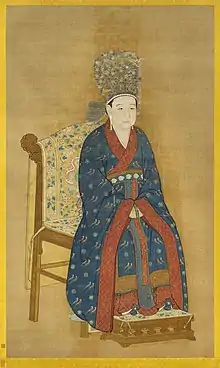Bixi (clothing)
Bixi (Chinese: 蔽膝; pinyin: bìxī; lit. 'Cover knee'; Korean: 폐슬; Hanja: 蔽膝; RR: Pyeseul), also known as fu (Chinese: 韍),[1] is a type of traditional Chinese decorative piece of fabric which acts as a knee covering.[2] It is a length of fabric which is attached to the waist and typically reaches the knee-level, covering the front legs.[3] Bixi originated from primitive clothing and since then, it continued to be worn and became part of the Chinese ceremonial attire.[2] The bixi was worn by both men and women.[4] Bixi originated in China and was later introduced in Korea during Goryeo and Joseon by the Ming dynasty, along with many garments for royalties.[5][6]
| Bixi | |||||||
|---|---|---|---|---|---|---|---|
 Illustration of a bixi found in the Chinese encyclopedia Gujin Tushu Jicheng, section "Ceremonial Usages", between 1700 and 1725 AD. | |||||||
| Chinese name | |||||||
| Chinese | 蔽膝 | ||||||
| Literal meaning | Knee cover | ||||||
| |||||||
| Alternative Chinese name | |||||||
| Chinese | 韍 | ||||||
| |||||||
| Korean name | |||||||
| Hangul | 폐슬 | ||||||
| Hanja | 蔽膝 | ||||||
| |||||||
History
The bixi originated from primitive clothing back when animal hides were used to cover the abdomen and the genitals.[2] During the Shang dynasty, the basic style of clothing for men and women consisted of yichang and bixi.[7] Among many other types of female clothing items, the bixi was listed in tomb inventories dating from 361 AD.[8] In the Ming dynasty, the bixi became part of the official clothing.[4]
 A Standing Dignitary wearing a bixi, Shang dynasty, 12th-11th century BC.
A Standing Dignitary wearing a bixi, Shang dynasty, 12th-11th century BC.
Bixi in set of attire
Men's Clothing
A red bixi was worn as part of the mianfu which was worn by the Chinese emperors.[2]
A crimson bixi was worn in the tongtianguanfu.[9][10]
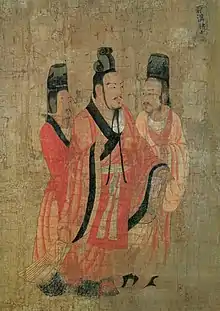
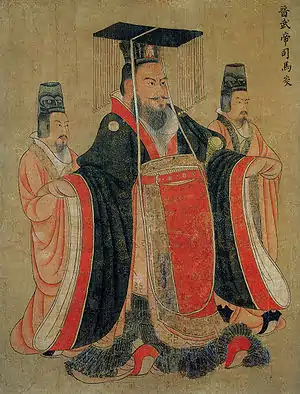 Mianfu of Emperor Wu of Jin dynasty, 7th-century painting by court artist Yan Liben
Mianfu of Emperor Wu of Jin dynasty, 7th-century painting by court artist Yan Liben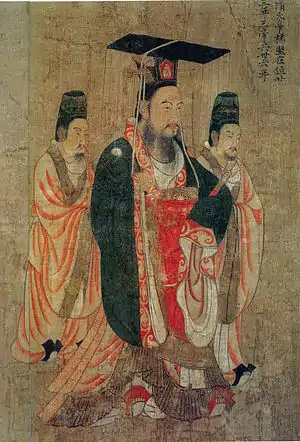 Emperor Wen of Sui, wearing mianfu.
Emperor Wen of Sui, wearing mianfu.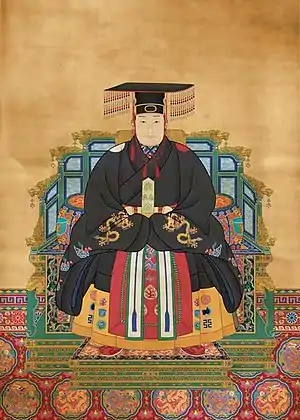 Wanli Emperor wearing a red bixi over his skirt as part of the mianfu set of attire, Ming dynasty.
Wanli Emperor wearing a red bixi over his skirt as part of the mianfu set of attire, Ming dynasty..jpg.webp) Emperor Xuanzu (宣祖) of Song wearing tongtianguanfu.
Emperor Xuanzu (宣祖) of Song wearing tongtianguanfu.
Gallery
See also
References
- Zhang, Fa (2016). History and spirit of chinese art. Honolulu. p. 13. ISBN 978-1-62320-130-2. OCLC 933763535.
- Hua, Mei (2011). Chinese clothing (Updated ed.). Cambridge, United Kingdom. p. 56. ISBN 0-521-18689-7. OCLC 781020660.
- Neo, Jocelyn; Yen, Li (23 December 2018). "Singapore Han Cultural Society: Reviving Chinese Han Couture (Hanfu)". The Epoch Times (Singapore). Retrieved 3 February 2021.
- Zhongguo xie zhen hua. Shanming Guan, 關善明 (Di 1 ban ed.). Xianggang: Mu wen tang mei shu chu ban she you xian gong si. 2003. p. 38. ISBN 988-97206-2-0. OCLC 56424659.
{{cite book}}: CS1 maint: others (link) - "폐슬(蔽膝) - 한국민족문화대백과사전". encykorea.aks.ac.kr. Retrieved 2021-12-28.
- "폐슬(蔽膝)". Encyclopedia of Korean Folk Culture. Archived from the original on 2019-06-16. Retrieved 2021-12-28.
- Lüsted, Marcia Amidon (2016). Ancient Chinese daily life (First ed.). New York. p. 22. ISBN 978-1-4777-8889-9. OCLC 957525459.
- Dien, Albert E. (2007). Six dynasties civilization. New Haven, Conn.: Yale University Press. p. 324. ISBN 978-0-300-07404-8. OCLC 72868060.
- 5000 years of Chinese costumes. Xun Zhou, Chunming Gao, 周汛, Shanghai Shi xi qu xue xiao. Zhongguo fu zhuang shi yan jiu zu. San Francisco, CA: China Books & Periodicals. 1987. pp. 108–109. ISBN 0-8351-1822-3. OCLC 19814728.
{{cite book}}: CS1 maint: others (link) - "宋代皇帝服饰:通天冠服 - 栖凤阁汉服网|最美中国风 尽在栖凤阁 Powered by Hishop". hanfudian.com. Retrieved 2021-12-22.
- Zhang, Shuhua; Shanat, Musdi bin Hj; Abdullah, Qistina Donna Lee (2021-03-31). "The Expression of Religious Elements and Factors of Religious Thoughts in the Empress's Ceremonial Costume "Hui Yi" of Song Dynasty". International Journal of Service Management and Sustainability. 6 (1): 89–108. doi:10.24191/ijsms.v6i1.12880. ISSN 2550-1569.
